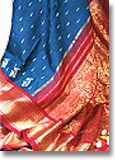What is Silk ?
 Man is always inquisitive for silk products. SILK - The Queen of Textiles, spells luxury, elegance, class and comfort. Mankind has always loved this shimmering fibre of unparalleled grandeur from the moment Chinese Empress Shiling Ti discovered it in her tea cup. It withstood many a daunting challenges from other natural and artificial fibres and yet, remained the undisputed Queen of Textiles since centuries. Exquisite qualities like the natural sheen, inherent affinity for dyes and vibrant colours, high absorbance, light weight, resilience and excellent drape etc. have made silk, the irresistible and inevitable companion of the eve, all over the world.
Man is always inquisitive for silk products. SILK - The Queen of Textiles, spells luxury, elegance, class and comfort. Mankind has always loved this shimmering fibre of unparalleled grandeur from the moment Chinese Empress Shiling Ti discovered it in her tea cup. It withstood many a daunting challenges from other natural and artificial fibres and yet, remained the undisputed Queen of Textiles since centuries. Exquisite qualities like the natural sheen, inherent affinity for dyes and vibrant colours, high absorbance, light weight, resilience and excellent drape etc. have made silk, the irresistible and inevitable companion of the eve, all over the world.
Chemically speaking, silk is made of proteins secreted in the fluid state by a caterpillar, popularly known as 'silkworm'. These silkworms feed on the selected food plants and spin cocoons as a 'protective shell' to perpetuate the life. Silkworm has four stages in its life cycle viz., egg, caterpillar, pupa and moth. Man interferes this life cycle at the cocoon stage to obtain the silk, a continuous filament of commercial importance, used in weaving of the dream fabric.
Why is Silk ?
Silk is a high value but low volume product accounting for only 0.2 % of world's total textile production. Silk production is regarded as an important tool for economic development of a country as it is a labour intensive and high income generating industry that churns out value added products of economic importance. The developing countries rely on it for employment generation, especially in rural sector and also as a means to earn the foreign exchange.
Where do we find Silk ?
Geographically, Asia is the main producer of silk in the world and produces over 95 % of the total global output. Though there are over 40 countries on the world map of silk, bulk of it is produced in China and India, followed by Japan, Brazil and Korea. China is the leading supplier of silk to the world.
India is the second largest producer of silk and also the largest consumer of silk in the world. It has a strong tradition and culture bound domestic market of silk. In India, mulberry silk is produced mainly in the states of Karnataka, Andhra Pradesh, Tamil Nadu, Jammu & Kashmir and West Bengal, while the non-mulberry silks are produced in Jharkhand, Chattisgarh, Orissa and north-eastern states.
Types of Silk ?
There are five major types of silk of commercial importance, obtained from different species of silkworms which in turn feed on a number of food plants. These are:
- Mulberry
- Oak Tasar & Tropical Tasar
- Muga
- Eri
Commercially exploited sericigenous insects of the world and their food plants
| Common Name | Scientific Name | Origin | Primary Food Plant(s) |
|---|---|---|---|
| Mulberry Silkworm | Bombyx mori | China | Morus indica M. alba M.multicaulis M.bombycis |
| Tropical Tasar Silkworm | Antheraea mylitta | India | Shorea robusta Terminalia tomentosa T. arjuna |
| Oak Tasar Silkworm | Antheraea proylei | India | Quercus incana Q. serrata Q. himalayana Q. leuco tricophora Q. semecarpifolia Q. grifithi |
| Oak Tasar Silkworm | Antheraea frithi | India | Q. dealdata |
| Oak Tasar Silkworm | Antheraea compta | India | Q. dealdata |
| Oak Tasar Silkworm | Antheraea pernyi | China | Q. dendata |
| Oak Tasar Silkworm | Antheraea yamamai | Japan | Q. acutissima |
| Muga Silkworm | Antheraea assama | India | Litsea polyantha L. citrata Machilus bombycina |
| Eri Silkworm | Philosamia ricini | India | Ricinus communis Manihot utilisma Evodia fragrance |
Except mulberry, other non-mulberry varieties of silks are generally termed as vanya silks. India has the unique distinction of producing all these commercial varieties of silk.






